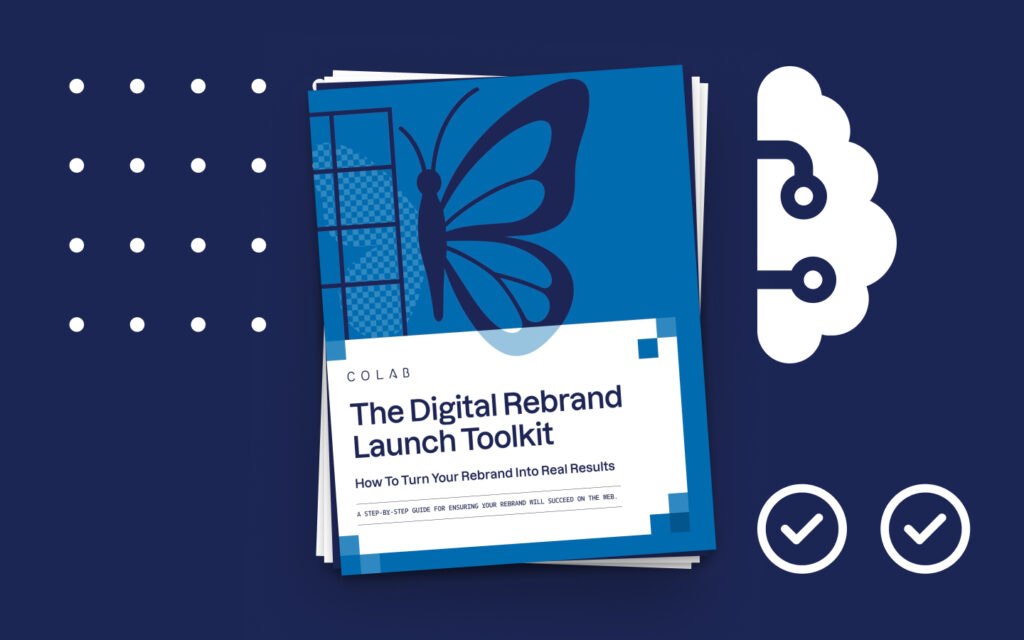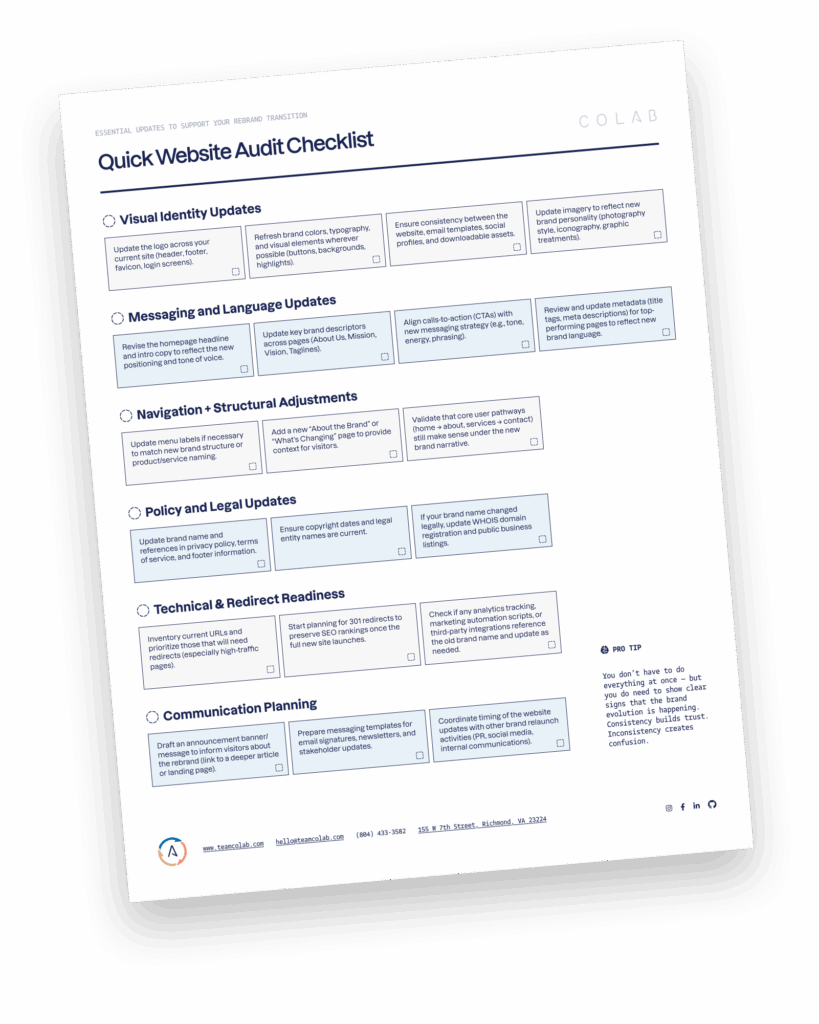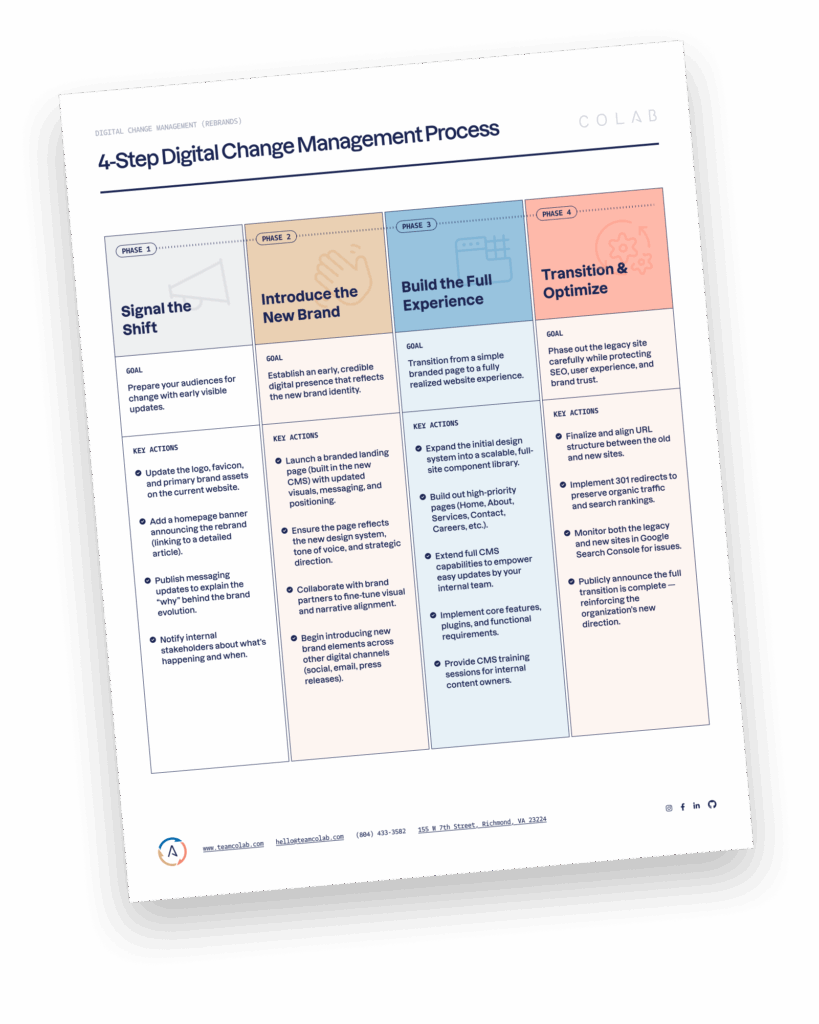Strategic Rebranding: A Digital Rebrand Toolkit to Guide Your Team Through Change

Rebrands are one of the most defining moments for organizations. They signal a shift in identity, vision, and direction. While introducing a fresh new logo, colors, and tagline to your digital properties can be exciting, there’s a real challenge in ensuring users’ experiences align with the reimagined brand. And how do you bring those users along with this change?
This is moment where an effective digital change management process is crucial. Without it, a rebrand risks creating confusion and inconsistency. With it, your digital rebrand can become a strategic milestone that strengthens trust and user loyalty.
This article takes you through what “managing the change” really means during a rebrand. Our guide has actionable steps, tools, and insights to execute a seamless digital transition. Plus, explore our digital rebrand toolkit, which we designed to help you through every stage of the process.
Where’s the Toolkit?
If you want to skip the article to get your download we’ll be sad, but we understand.
Understanding Rebrand and Change Management
Undergoing a rebrand isn’t as simple as replacing your logo and adopting fresh typography or a new color scheme. You are redefining who you are as a business and communicating that transformation to all stakeholders, not just your customers. Change management, in this context, refers to the structured approach you take to ensure that every transition is seamless and aligned with the new brand identity. These actions should cover all aspects of the change, ranging from employee understanding to customer experience.
What Poor Change Management Looks Like
- Customers visit your website and still see the old logo from months ago.
- Internal teams forget to update emails or presentations with the refreshed branding.
- Stakeholders are caught off guard, feeling unsure about what drove the change and why it matters.
- There’s no strategy behind sunsetting your old digital properties, leaving customers wondering if they’ve landed in the wrong place.
- Lost critical SEO assets due to improper URL redirects or out-of-date metadata.
What Great Change Management Achieves
- Your audience sees clear, consistent updates across every digital channel.
- Employees and stakeholders are made aware of the change and what is coming; they know what to expect.
- All stakeholders are excited about the rebrand and aligned with its purpose.
- Customers immediately understand what’s changed and are drawn to explore further.
- Your digital foundations, such as SEO and analytics tracking, remain intact and strengthened.
Now that you know how to avoid the pitfalls, let’s talk about creating a strategy that works.
How to Execute a Seamless Rebrand Transition
Below is a step-by-step framework and checklist to guide your brand evolution while safeguarding your digital presence.
Start with a Quick Website Audit
Before launching the new brand in full, implement critical updates across your existing website. This step reassures audiences that your evolution is well underway and builds trust.
Key Actions
- Update your logo, favicon, and any visual elements, such as buttons or backgrounds, to reflect the new brand.
- Revise Homepage, About Us sections, mission statements, and metadata to feature the new tone and vocabulary.
- Refresh assets across your email templates, social media profiles, and downloadable materials for consistency.
🧠 Pro Tip: You don’t need to overhaul everything at once, but clear, visible updates are essential to signal progress.

Our Quick Website Audit Checklist and Guide
You can download a printable quick website audit to help with this.
Align Messaging and Language
A rebrand is as much about the story as the visuals. Making sure your written voice evolves alongside the new brand’s personality ensures you create a holistic user experience.
Key Actions
- Rewrite headlines, key descriptions, and CTAs to match the new brand’s tone and energy.
- Replace outdated slogans or taglines across pages and marketing materials.
- Check metadata like page titles and descriptions for continuity.
Clear language isn’t just functional, it reassures your audience that the new vision is intentional, credible, and exciting.
Develop a Rebrand-to-Web Rollout Plan
A rebrand shouldn’t happen in one gigantic sweep. Breaking it into digestible phases allows room for testing, corrections, and smoother adoption.
Phase Breakdown
Phase 1: Week 1-2 – Signal the Shift
- Update logos, primary brand visuals, and metadata to start building recognition.
- Announce the rebrand publicly through homepage banners or email campaigns.
Phase 2: Week 2-4 – Introduce the New Brand
- Launch a branded landing page that reflects key components of the new identity.
- Introduce new messaging and visual identity throughout your social channels.
Phase 3: Week 4-20 – Build the Full Experience
- Gradually replace high-priority pages like services, contact, and about sections with new site designs.
- Add all structural improvements, plugins, and key tools your team needs going forward.
Phase 4: Week 18-20 – Transition & Optimize
- Phase out the legacy site while preserving SEO and user trust.
- Monitor both the new and legacy site to ensure continuity.
🧠 Pro Tip: During phase four, make sure your legacy site is phased out strategically with proper redirects (for both pages and assets) to protect SEO performance.

Our 4-Step Digital Change Management Process
You can download a mini process doc visual to help with this.
Communication Is Everything
The way you communicate a rebrand matters just as much as the updates themselves. Create tailored messaging for different audiences, reinforcing leadership, reassurance, and transparency.
Stakeholder Communication Map
- Customers: Focus on what’s changing and what stays consistent (e.g., core mission). Use emails, blog updates, and social announcements for outreach.
- Internal Teams: Prepare your employees with FAQs, internal newsletters, and town-hall briefings to manage the transition confidently.
- Media and Press: Announce publicly with formal press releases and interviews highlighting your future direction.
- End Consumers (if applicable): Use in-app messages, emails, or help articles to guide users through any functional changes clearly.
Timed and relevant messages keep everyone confident, preventing unnecessary confusion or misinformation.
Preserve and Elevate Digital Foundations
A successful transition fully safeguards your digital assets—from SEO rankings to analytics tracking. Here’s how to protect and enrich your online presence during the rebrand.
SEO Safeguards
- Inventory top-performing URLs and set 301 redirects to maintain rankings.
- Update alt text for images and ensure they reflect the updated branding.
- Monitor the legacy and new sites post-launch for broken links or significant traffic dips.
Technical Health
- Verify that all third-party integrations reflect brand updates (including analytics and marketing automation).
- Enable CMS updates that empower internal teams to create on-brand content with minimal effort.
Testing Infrastructure
- Conduct cross-device performance tests to ensure a smooth experience regardless of how users access your site.

Leverage Our Full Digital Rebrand Toolkit
For businesses ready to reimagine their digital identity and maintain momentum, our Digital Rebrand Toolkit condenses these best practices into actionable checklists, scheduling templates, and stakeholder maps. Sign up to access the toolkit and ensure your rebrand is smooth, strategic, and impactful.
It’s Time to Shape Your Future
A rebrand is more than a fresh coat of paint. It’s your company’s new chapter, but only if done thoughtfully. By approaching the process with alignment, clarity, and thorough planning, you won’t just reintroduce your business to the world. You’ll reaffirm your position in it.
Don’t go it alone. Book a strategy session with our experts to ensure your new brand launch is an undeniable success.
Planning a rebrand?
We help organizations move forward with clarity and confidence.

